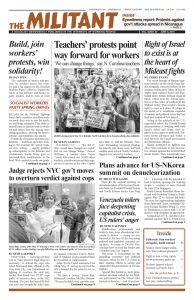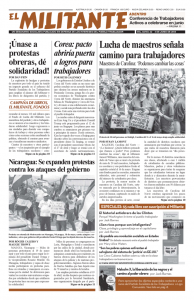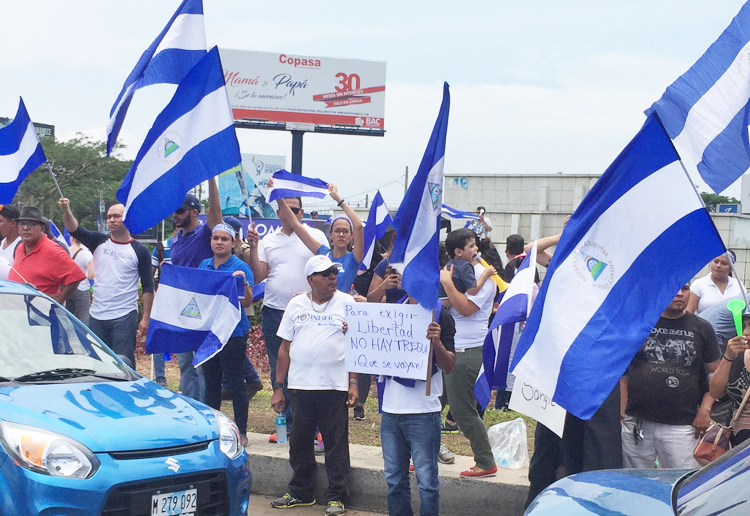MASAYA, Nicaragua — Thousands rallied here and in cities across the country May 19 to demand the resignation of President Daniel Ortega and Vice President Rosario Murillo. In Managua, workers and middle-class layers gathered in peaceful protests on street corners and drove in caravans around the city. They stopped and visited university campuses occupied by students since protests exploded a month ago to express solidarity.
Thousands of others gathered in León, Matagalpa, and Estelí, marching in city streets where paving-stone barricades erected since April by residents in working-class neighborhoods to defend themselves from attacks by police and pro-government thugs remain in place. Some were the sites of pitched battles that have left more than 70 dead and hundreds wounded.
Widespread protests exploded April 19, the day after goons organized by the Sandinista Youth, an organization led by the ruling party, the Sandinista National Liberation Front (FSLN), attacked some retirees in León protesting against government proposals to increase workers’ contributions to the country’s pension fund and cut benefits.
University students rallying on campuses in support of the pensioners were attacked by riot police and government-organized paramilitaries. To defend themselves, students at the Polytechnic, Agrarian, and Engineering universities occupied campus buildings and barricaded themselves inside.
The killings and wounding of the students — and Ortega and Murillo’s denial of brutal repression by police and paramilitary thugs and their dismissal of protesters as miniscule groups of looters, right-wing gangs and youth manipulated by opposition forces — have generated even more indignation and incited more protests. “They were students, not delinquents!” is a slogan heard in all the actions, seen as well as on T-shirts, signs and graffiti on walls everywhere.
“We stand behind our elderly and our young people,” said craft vendor Ervin Potosme, 57. Potosme, like many of the protesters, still considers himself a supporter of the revolutionary ideals fought for by the FSLN, which led the struggle that overthrew the U.S.-backed dictatorship of Anastasio Somoza on July 19, 1979, opening a deep-going popular anti-capitalist revolution.
The government that came to power on the shoulders of that mass insurrection mobilized workers and peasants to fight for land reform and workers’ rights; build their own organizations; take greater control of factories; and carried out other measures in favor of the toilers.
But the FSLN leadership became increasingly dominated by those, like Ortega, who backed away from a revolutionary course, rejecting any idea of following the example of Cuba and its socialist revolution. This evolution accelerated in the late 1980s, marking the beginning of the FSLN’s degeneration into a bourgeois electoral party. By 1990 the Sandinista revolution was over.
Potosme took part in the 1978 insurrection that exploded in the Monimbó neighborhood of this city against the Somoza dictatorship. This working-class neighborhood, whose population is largely of indigenous descent, has served as an inspiration and as an emblem of courage and resistance to tyranny for Nicaraguan toilers.
The main rally here was held at La placita, the main plaza and heart of Monimbó. Protesters came from all sections of Nicaraguan society and from a wide range of viewpoints, including supporters of opposition parties, longtime opponents of the Sandinista Front, as well as workers who were part of the revolution in the 1980s.
Calero and Trowe are in Nicaragua reporting for the Militant. We will carry further coverage next week.


